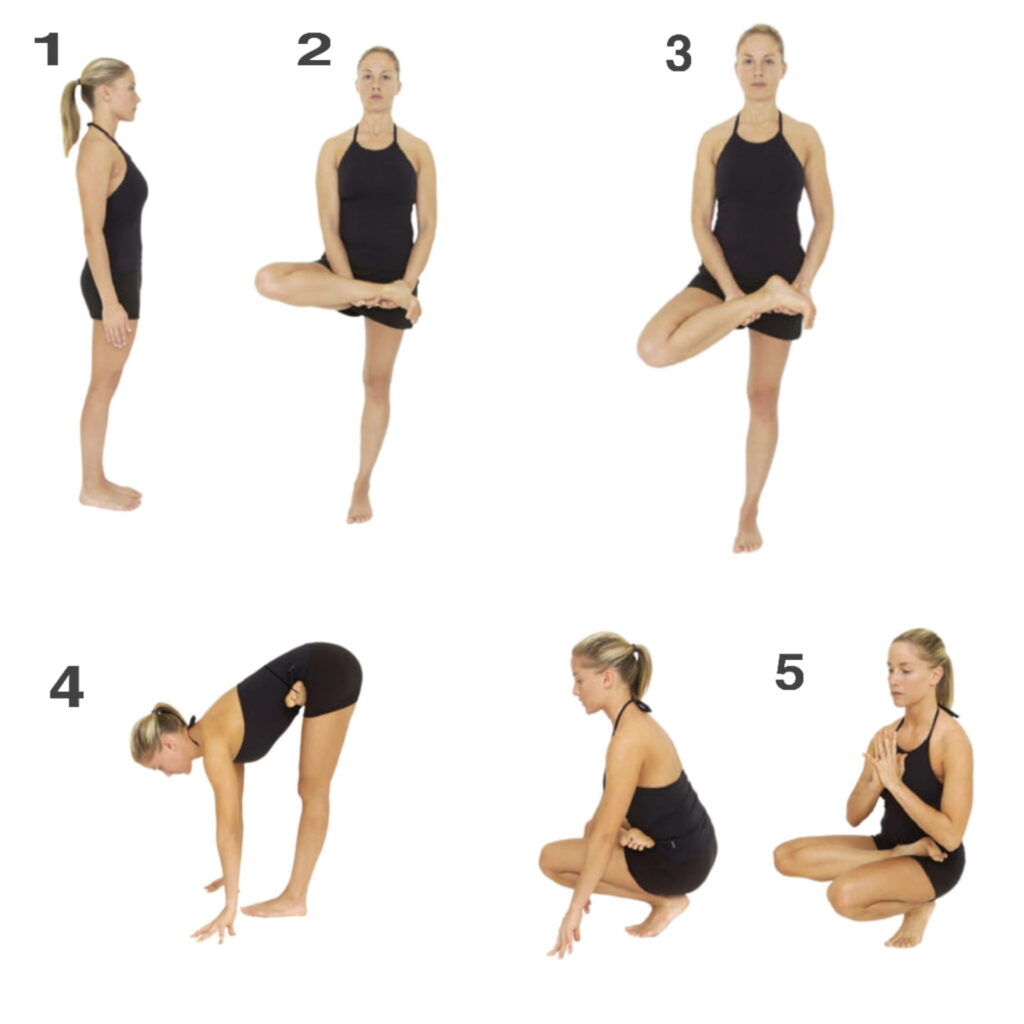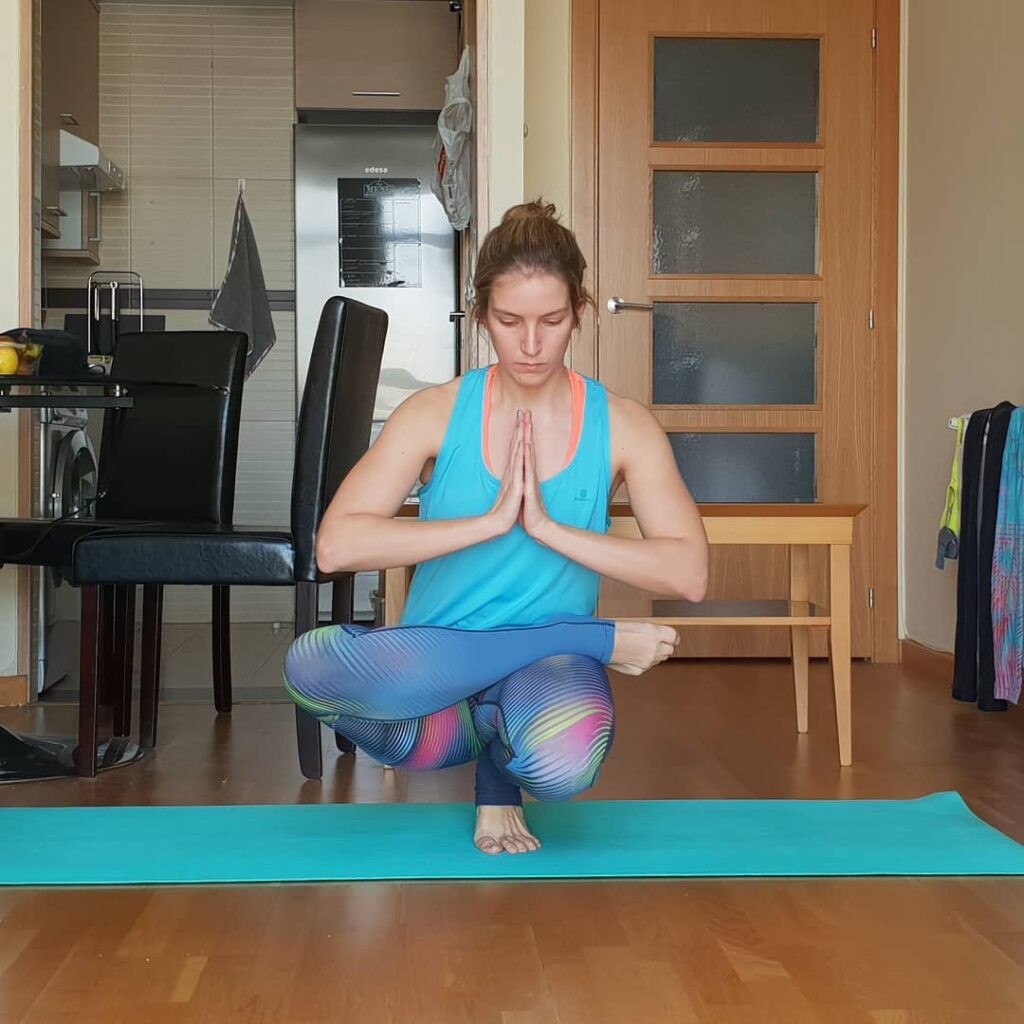The amazing Toe Stand Pose, also known as Tiptoe Pose or Padangusthasana in Bikram Yoga, challenges the strength of the knees and ankle joints and the flexibility of the hips while maintaining balance.
Toe Stand Pose or Tiptoe Pose is a variation of Toe Balance Pose (Prapadasana), where one hip is in an external rotation, locking the foot at the hip joint, such as the Half Lotus Tree Pose (Ardha Padma Vrksasana).
Sanskrit Meaning
Ardha Baddha Padma Padangusthasana is derived from Sanskrit. Its name has six Sanskrit terms as follows:
- Ardha + Baddha + Padma + Pada + Angustha + Asana:
- “Ardha” = “half”
- “Baddha” = “bound”
- “Padma” = “lotus”
- “Pada” = “foot”
- “Angustha” = “big toe”
- “Asana” = “pose or posture”
In Bikram Yoga, this yoga pose is derived from the Sanskrit name “padangusthasana”, which translates to “Big Toe Pose”. However, this is not to be confused with the Ashtanga Vinyasa variation of Big Toe Pose (also known as “Padangusthasna”), which is a standing forward fold pose.
Information
| Known as: | Toe Stand Pose, Tiptoe Pose, Ardha Baddha Padma Padangusthasana, Half Bound Lotus Tip Toe Pose, Half Lotus Tip Toe Pose, Samatvam Asana, Padangustha Padma Utkatasana, Single Toe Balance Pose, Padangustasana |
| Sanskrit name: | अर्ध बद्ध पद्म पादन्गुष्ठासन; पादन्गुष्ठासन |
| IAST: | Pādanguṣṭhāsana |
| Pronunciation: | pahd-ang-guhs-TAHS-uh-nuh |
| Type: | Balancing |
| Level: | Intermediate |
| Drishti: | At fingertips; Forward; Eyes closed |
| Total time: | 30–60 seconds |
| Focus: | Legs |
| Indications: | Ankles, knees, and hips, feet, calves, hamstrings, thighs, balance, stability, posture, stress, digestion, elimination, circulation and swelling in the legs and feet |
| Chakra: | Swadisthana Chakra, Muladhara Chakra |
| Counterposes: | Tadasana, Uttanasana, Urdhva Prasarita Ekapadasana |
| Preparatory poses: | Standing Forward Bend (Uttanasana), Garland Pose (Malasana), Low Lunge (Anjaneyasana), Hero Pose (Virasana), Half Pigeon Pose (Ardha Kapotasana) |
| Follow-up poses: | Child’s Pose (Balasana), Downward-Facing Dog (Adho Mukha Svanasana), Reclining Hero Pose (Supta Virasana), Seated Forward Bend (Paschimottanasana), Corpse Pose (Savasana) |
| Contraindications: | Low blood pressure, High blood pressure, Headache |
Benefits of Toe Stand Pose
The practice of the Toe Stand Pose or Tiptoe Pose has its roots in the Pradapasana (Toe Balance Pose) and Ardha Padma Vrksasana, so the benefits derived from these poses can also be referred to. In addition, physical and mental benefits are given below:
- Physical Benefits:
- Improves balance
- Improves digestion and circulation
- Strengthens the arches, ankles, calves, and thighs
- Lengthens the spine
- Relieves symptoms of sciatica
- Opens the shoulders, chest, thighs, and hips
- Mental Benefits:
- Cultivates poise
- Calms the mind
- Builds focus
- Develops willpower
Step by step Toe Stand Pose or Tiptoe Pose

- To begin, stand in Tadasana (Mountain Pose).
- Balance on the left leg. Bend the right knee, hold your right foot, and draw your knee out to the side. Take the heel up toward your navel.
- Roll the right foot and leg forward and down, and place your foot at the left thigh crease. Keep the top of the left thigh back. Press the toes back into your left thigh.
- Bend forward at the waist and touch the floor.
- Keep the right foot drawn in close in the thigh crease. Hug the leg muscles from your knees into the pelvis. Keep the toes spread and active. Keeping the hands in contact with the floor, bend your left knee and sit down on your left heel. Place the left heel near the perineum, up off the floor.
- Balance on the left heel by bringing your hands up to prayer position. Hold for 30-60 seconds, then come out of the pose and repeat this process on the other side.
Modification and variation
Practicing Toe Stand Pose or Tiptoe Pose can be a great way to gain leg and abdominal strength, challenging your concentration and spirit. Try these simple changes to optimize the yoga pose for your current abilities:
- Just bring your leg upwards as far as you can without causing pain. If you are unable to rest your leg on your hip, place it on your standing leg thigh.
- If you are having trouble getting on the floor while balancing, practice the posture with your back against the wall for extra support. Alternatively, place a chair next to your body standing-feet. Place your hand on the chair for extra help with the posture.
- For greater challenge in the full version of asana, close your eyes. Practice balance without using the outside world for reference.
Contraindications
The practice of the Toe Stand Pose or Tiptoe Pose is an intermediate level practice that strengthens both balance and posture. Therefore, yoga practitioners should keep in mind several precautions while practicing this yoga pose, which are given below:
1. Injury and surgery
Toe Stand Pose or Tiptoe Pose should be avoided by individual with knee and ankle injuries. This should clearly be avoided for those who have had recent surgery in their legs, hips, knees, or pelvis.
2. Sickness and physical strength
Individuals with weak hips, knees, and ankles should avoid performing this pose. Also, if individuals experience balance and problems that cause dizziness or discomfort in their breathing, then it is best to avoid teaching such individuals. Given that this yoga pose is an intermediate level exercise, which affects the body and breath with vertical issues, blood pressure, arthritis or any other physical condition, this practice should be avoided.
3. Senior or pregnant woman
Certainly not for senior or pregnant women, as both stress and tension occur in the abdomen, pelvis, and various joints.
4. Lack of body-breath connections
Individual with trauma and anxiety or lacking the body’s breath connection should avoid this yoga pose. Balancing them can be challenging in such scenarios. The fear of deteriorating balance can damage their mental state, and in the process injure their joints, especially the tailbone, as it takes body weight and pushes itself against the heel of the balancing leg.















